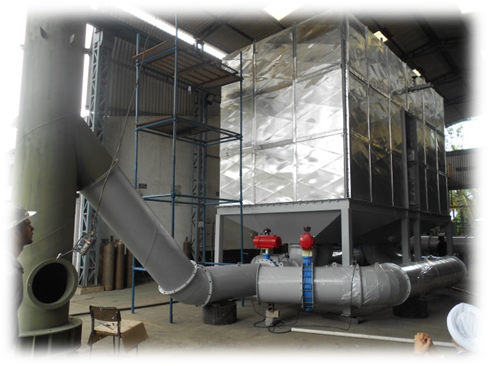
Mechanisation & Automation in Incinerator manufacture and operation
Making an incinerator is an arduous task. Fabrication of metal sheets and plates involves cutting, rolling and welding; refractory lining involves multiple layers of different refractory materials on to properly designed anchors, preparation and painting, assembly, testing, etc.
It is time consuming. It is labour-oriented. It is not an assembly line production. It cannot be produced with a CNC machine. There are many ways to describe how a difficult job it is to make an incinerator.
Having said all that, we realised these issues in the formative years and planned and worked out a manufacturing philosophy by which we could mechanise some of the operations, so that this results in
- less time in manufacture
- consistent quality
- greater output
- less dependence on manual labour
- faster deliveries
- addressing environment and safety
We analysed the various stages of manufacture and came up with solutions for each step.
Fabrication:
Cutting - The sheets are fed into a hydraulic shear and in a matter of a few minutes a 1.5 m. wide sheet is cut into different lengths.
Rolling - Again rolling machines, hydraulically or electrically operated would give shape to the cut steel sheets very quickly indeed.
Welding - In recent times, manual welding has yielded place to semi-automatic welding with MIG welding using CO2 or flux cored wires. This does away with time taken for removing the slag, spatter, etc. as these do not produce any of these. In addition, there are special purpose machines and fixtures such as weld positioners, column and boom systems, etc. which facilitate a fabricator to position the job to be welded on the fixtures and obtain weld finishes which are far better than manual welding. These fixtures enable x-ray quality welds with excellent finish, requiring no further cleaning or grinding.
Painting & Preparation
We realised surface preparation is the key to paint life of the equipment. We adopt standards and codes such as IS 8501-1 NACE SA 2 1/2, SSPC SP 10/NACE No.2, ASTM D 4417, etc. for preparation (and testing) which gives a certain minimum depth on the metal surface, so that when painted, the paint has a much larger surface area and depth to cover. Moreover, all the mill scale and rust are fully removed in this process. This is done semi-automatically using a blasting machine. No sand blasting is done on our machines to eliminate possibility of corrosion due to salt contamination. Only steel grits of specific sizes are used, which give excellent preparation, prior to painting.
The actual painting is done inside a specially constructed paint booth with fume filters and extraction fans. The booth is constantly maintained at a particular temperature. This helps us to do the painting at a controlled temperature, irrespective of the atmospheric temperature. The movement of the incinerator shells, both in the blasting and painting booths are done using electrical winches with very little manual intervention.
The environmental impact on account of our painting and blasting is very limited as the network is connected to a bag filter which eliminates fine dust from flying out to the atmosphere.
Refractory work
This is generally done manually, be it bricks or castables. However, some of our dedicated technicians, in consultation with the refractory manufacturer, have designed moulds of suitable shapes and sizes, which enable the refractory mason to just pour the castables within the mould, vibrate it to settle down. What you get thus is a neat and finely finished refractory lining which does not need any further dressing. Each segment of the incinerator, when joined together, aligns itself without any problem. This work takes less than 30% of the time it takes to manually line the incinerator.
Incinerator operation:
This consists of loading the waste, switching on the burners, fans, etc. removing the ash residue at the end of the operation.
These have been simplified thus:
Loading
There are mechanised systems specially designed such as hydraulic ram loader, conveyor, DFDV, etc., (for solid wastes). This not only reduces the time taken for loading, it also prevents the operator from exposure to heat. The liquid and gaseous wastes are automatically charged to the chamber.
Incineration process
In the case of liquid or gaseous waste, no manual intervention is required. The waste gas/liquid is directly fed into the chamber through control valves, butterfly valves, liquid discharge systems like sludge/screw pumps, etc. Only in the case of solid wastes, the waste is required to be loaded through the loading mechanisms.
De-ashing
Hydraulic/Pneumatic de-ashing systems are available, which enable removal of ash after incineration and cooling down, without any manual work, except to collect the ash at the outlet of the chamber.
Control philosophy
Systems are available now, where the entire operating philosophy is captured in a PLC and/or a HMI which not only helps in the automatic operation and control of the entire incinerator system using the HMI, it enables the operator/supervisor also to know the many parameters including pressure, temperature, emission, etc. at any given time.
Installation & commissioning
These above activities make life easier for the installation and commissioning team as well as the customers’ operators. There will be no glitches in assembly and installation at site, no rework or any site work. Refractory curing is already done in the shops prior to dispatch. The installation is done quickly and the incinerator made ready for operation.
One can observe from the above that what was earlier a fully manual manufacturing process and operation has been converted to a mechanised and semi-automatic process (and fully automatic in some cases). This has not only enabled reduction in production time and operator fatigue, it has also addressed environmental and employee safety concerns.


